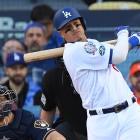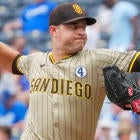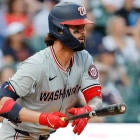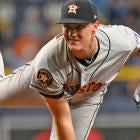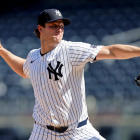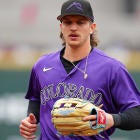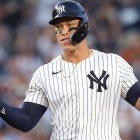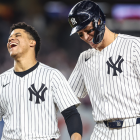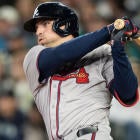Alex Chamberlain is a 5-time Fantasy Sports Writers Association (FSWA) award finalist and was recognized as 2015's Newcomer of the Year and 2018's Baseball Writer of the Year. He competes in Tout Wars and contributes (other) work online at RotoGraphs and in print in Lindy's Sports annual Fantasy Baseball magazines. He has also written at Baseball Prospectus and Rotoballer. His content will be available to SportsLine subscribers all Fantasy baseball season long. Here's a preview of what you'll be getting this season with a subscription. Use promo code 'SCORE' to get Alex's content, plus more exclusive content, stats, tools, and data from our team of exports.
I posed a question on Twitter the other day asking folks to characterize what kind of impact a player's team might have on his production (by measure of runs and runs batted in, two cornerstone Fantasy categories).
Mostly, this is an exercise in bias, although more qualitative than quantitative in nature: how many more (or fewer) runs and RBI might a player accrue on a good (or bad) team? The timing of this poll was no accident, as Manny Machado had signed to the rebuilding San Diego Padres mere hours earlier. I declined to state my opinion, reluctant to influence the outcome:
how much does team context/talent affect how you project (or, if you don't create your own projections, mentally adjust an existing projection of) R and RBI for a hitter?
— Alex Chamberlain (@DolphHauldhagen) February 20, 2019
Most voters said they adjust, whether tangibly or mentally, the counting stat production of players based on their team context or overall team talent. Some went as far as to say it has a huge impact, but almost no one said there's no impact. I suspected this might be the case, although the small turnout for "no impact" was lower than I expected.
Allow me to convert you — statistically, probably a "small impact" or "medium impact" person — as I try to convert myself to the dark side. Join me on Team No Impact.
I run my own projections each year. This is not some mathematical flex; my projections are rather crude and surely pale in comparison to the major projection systems with which you're most familiar (namely, Steamer and ZiPS). Mostly, I use my projections to identify discrepancies with the aforementioned projections in an effort to identify market inefficiencies (i.e., mis-valued players). I present this extraneous information as a caveat that someone smarter than me may have stronger evidence to the contrary, but from where I'm standing, the evidence is incontrovertible.
Despite the crudeness of my projections, there's one thing that stands out clearly to me: runs and RBI are rather easy to project, and they don't require much more than the components of a player's on-base events — his singles, his home runs, his walks, etc. — and his spot in the batting order. That's it.
The following table shows the adjusted r2, a measure of correlation that describes how strong a relationship is from 0 to 1, for regression equations between production (runs and RBI), the dependent variable, and on-base components of production (singles, doubles, triples, home runs, walks, hits by pitch, and/or at-bats/plate appearances), the independent variables.
| Batting Order | R | RBI |
|---|---|---|
| 1st | 0.974 | 0.970 |
| 2nd | 0.958 | 0.964 |
| 3rd | 0.957 | 0.976 |
| 4th | 0.940 | 0.978 |
| 5th | 0.898 | 0.938 |
| 6th | 0.839 | 0.906 |
| 7th | 0.851 | 0.866 |
| 8th | 0.875 | 0.907 |
| 9th | 0.890 | 0.860 |
A hitter's production, broken down to its most basic building blocks, combined with his spot in the batting order, explains anywhere from 84 percent to 98 percent of his run and RBI production. Remarkably, the strongest relationships are at the top of the order, where hitters with the most Fantasy relevance typically reside. Again, these relationships bear no influence whatsoever from team context in terms of the quality of hitters batting in front of or behind the player in question. On a plate-appearance basis, Machado batting in front of Joey Votto or Jeff Mathis appears to make hardly any difference.
I should note, however, two additional caveats. One: this does not preclude the role of park factors. Petco Park is a tough hitters' environment, far more unforgiving than Camden Yards. That is an adjustment that affects Machado's production for which we must account. It warrants knocking him down a peg or two. But park factors does not equal the quality of a hitter's teammates.
Two: team context, while having little to no effect on production, does affect volume. The correlations in the table above have effectively controlled for volume as an outside force by scaling down to the individual plate appearance. The best-hitting team in the league might accrue 350 more plate appearances than the worst-hitting team over the course of the season. For a leadoff hitter, that difference could amount to as many as 70 plate appearances; for a three-hole hitter, like Machado, maybe closer to 55 or 60. I would be a fool to think that's not a big impact. But this kind of wholesale adjustment affects scarcely anyone. For Machado, moving from a neutral, team-less projection to the San Diego Padres might cost him, say, 20, maybe 30, plate appearances in a full 162-game season. After it all shakes out, the difference in production is maybe two or three runs and RBI apiece. I find myself having a hard time fretting over this.
If anything, Fantasy owners should be more keen to adjust production on the basis of batting order. Runs behave pretty intuitively: they decrease marginally as you go down the order, simply because hitters who hit higher in the order will accrue more plate appearances than hitters who hit lower in the order. RBI behave intuitively, too, but with one wrinkle — the lead-off hitter has far fewer RBI opportunities than the No. 2 or No. 3 hitter. Again, this is intuitive, but it bears repeating: a hitter who bats first every single game of the season has no runners on for roughly 20 percent of his season. That's a big sacrifice to make — one that the increase in runs fails to offset. Accordingly, the most ideal spot in the batting order, at least for Fantasy purposes, is second.
But that's beside the point. Given the evidence at my disposal, I have not mentally debited Machado's production (as projected for new park factors) with the anticipation that his teammates will drag him down, especially when team-level projections, in and of themselves, can be wildly noisy (maybe the Padres will be good this year!). If you're considering knocking down Machado a peg or two, sure, go for it. If you're mid-draft and need a quick mental tiebreaker, I would be OK with using it as the deciding factor. I'm most inclined to evaluate the effect that a Trade Deadline move from a very bad team to a very good team might have on a hitter — but even then, the effects would bear out across just two months of a season, resulting in similarly small differences perhaps not worth caring too deeply about.
Ultimately, Machado's move to sunny Southern California has done little to taint my mental picture of him. For Machado, I'm Team No Impact; he's a good hitter in a bad park surrounded by a potentially bad but also interesting array of bats. I'm worried more significantly about Petco Park stifling Machado's bat than his teammates doing so. For other hitters in more extreme situations, I might conditionally waver and lean Team Small Impact. Mostly, I'm fighting the urge to let this bias of team quality too heavily cloud my judgment. Don't let it get to your head.












